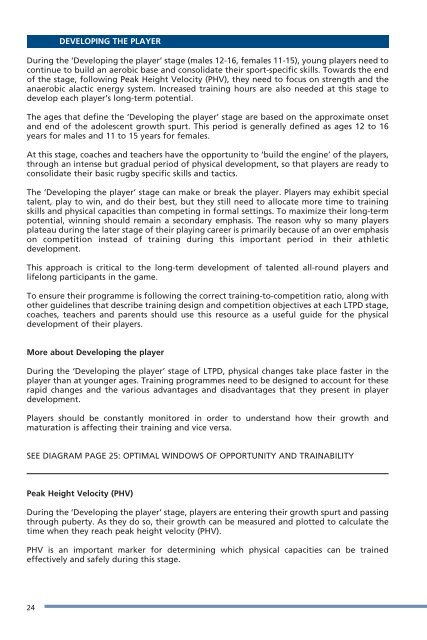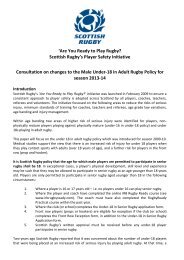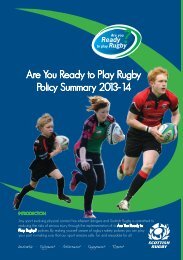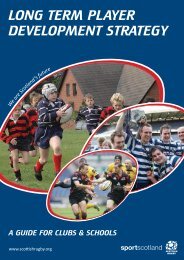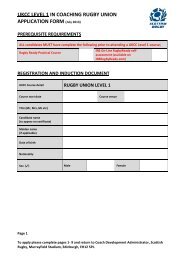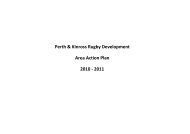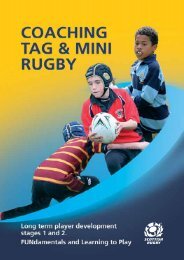LTPDst3cover.qxd (Page 1) - Scottish Rugby Union
LTPDst3cover.qxd (Page 1) - Scottish Rugby Union
LTPDst3cover.qxd (Page 1) - Scottish Rugby Union
- No tags were found...
You also want an ePaper? Increase the reach of your titles
YUMPU automatically turns print PDFs into web optimized ePapers that Google loves.
DEVELOPING THE PLAYERDuring the ‘Developing the player’ stage (males 12-16, females 11-15), young players need tocontinue to build an aerobic base and consolidate their sport-specific skills. Towards the endof the stage, following Peak Height Velocity (PHV), they need to focus on strength and theanaerobic alactic energy system. Increased training hours are also needed at this stage todevelop each player’s long-term potential.The ages that define the ‘Developing the player’ stage are based on the approximate onsetand end of the adolescent growth spurt. This period is generally defined as ages 12 to 16years for males and 11 to 15 years for females.At this stage, coaches and teachers have the opportunity to ‘build the engine’ of the players,through an intense but gradual period of physical development, so that players are ready toconsolidate their basic rugby specific skills and tactics.The ‘Developing the player’ stage can make or break the player. Players may exhibit specialtalent, play to win, and do their best, but they still need to allocate more time to trainingskills and physical capacities than competing in formal settings. To maximize their long-termpotential, winning should remain a secondary emphasis. The reason why so many playersplateau during the later stage of their playing career is primarily because of an over emphasison competition instead of training during this important period in their athleticdevelopment.This approach is critical to the long-term development of talented all-round players andlifelong participants in the game.To ensure their programme is following the correct training-to-competition ratio, along withother guidelines that describe training design and competition objectives at each LTPD stage,coaches, teachers and parents should use this resource as a useful guide for the physicaldevelopment of their players.More about Developing the playerDuring the ‘Developing the player’ stage of LTPD, physical changes take place faster in theplayer than at younger ages. Training programmes need to be designed to account for theserapid changes and the various advantages and disadvantages that they present in playerdevelopment.Players should be constantly monitored in order to understand how their growth andmaturation is affecting their training and vice versa.SEE DIAGRAM PAGE 25: OPTIMAL WINDOWS OF OPPORTUNITY AND TRAINABILITYPeak Height Velocity (PHV)During the ‘Developing the player’ stage, players are entering their growth spurt and passingthrough puberty. As they do so, their growth can be measured and plotted to calculate thetime when they reach peak height velocity (PHV).PHV is an important marker for determining which physical capacities can be trainedeffectively and safely during this stage.24


